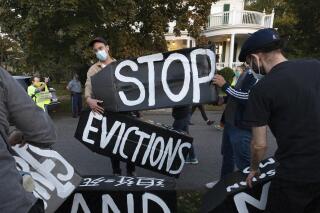EXPLAINER: How Maryland is distributing aid to help tenants

FILE - In this Oct. 14, 2020, file photo, housing activists erect a sign in Swampscott, Mass. A federal freeze on most evictions is set to expire soon. The moratorium, put in place by the Centers for Disease Control and Prevention in September, was the only tool keeping millions of tenants in their homes. (AP Photo/Michael Dwyer, File)
ANNAPOLIS, Md. (AP) — A federal freeze on most evictions enacted last year is scheduled to expire Saturday, after President Joe Biden’s administration extended the original date by a month. The moratorium, put in place by the U.S. Centers for Disease Control and Prevention in September, was the only tool keeping millions of tenants in their homes. Many of them lost jobs during the coronavirus pandemic and had fallen months behind on their rent.
Landlords successfully challenged the order in court, arguing they also had bills to pay. They pointed out that tenants could access nearly $47 billion in federal money set aside to help pay rents and related expenses.
Advocates for tenants said the distribution of the money had been slow and that more time was needed to distribute it and repay landlords. Without an extension, they feared a spike in evictions and lawsuits seeking to boot out tenants who were behind on their rents.
Even with the delay, roughly 3.6 million people in the U.S. as of July 5 said they face eviction in the next two months, according to the U.S. Census Bureau’s Household Pulse Survey. The survey measures the social and economic effects of the coronavirus pandemic every two weeks through online responses from a representative sample of U.S. households.
Here’s the situation in Maryland:
WHAT’S THE STATUS OF EVICTION LIMITS IN THE STATE?
Maryland Gov. Larry Hogan has extended the state’s limits on evictions through Aug. 15. The state’s limits provide a legal defense for tenants if they can show a substantial loss of income from COVID-19. Qualifying situations include a substantial decrease in income due to job loss, reduction in compensated hours of work or the need to miss work to care for a school-age child. A judge decides in each case whether sufficient evidence has been provided.
WHAT’S BEING DONE TO HELP PEOPLE FACING EVICTION?
Maryland has been allocated more than $700 million from two rounds of federal funds for emergency rental assistance. Much of it has gone to the state while some has been sent directly to local governments. A large portion remains to help. State officials say about $49 million has been spent so far, and they are raising awareness about available money and how to get help through mailings, as well as television, radio and social media ads. They also have established a call center (877-546-5595). “The word is getting out, but we need to keep getting it out,” said Sen. Shelly Hettleman, a Baltimore County Democrat. United Way of Central Maryland has been working with local governments to expand its Strategic Targeted Eviction Prevention program.
HOW ARE THE COURTS HANDLING EVICTION HEARINGS?
Maryland courts are fully operational, though they are still enforcing social distancing, which leads to smaller dockets. Judge John Morrissey, the chief judge of Maryland’s district courts, told lawmakers at a recent hearing that the courts are operating at about 75% of their typical case load, compared to before the pandemic. District courts are hearing landlord-tenant cases, including failure to pay rent and breach-of-lease cases. Judges have been making determinations about how much rent is due in such cases but have been deferring entering judgments until the moratoriums expire. It’s believed a majority of tenants have used the Maryland limits on evictions rather than the CDC’s, Morrissey said.
WHAT IS THE AFFORDABILITY IN THE STATE’S MAJOR RENTAL MARKETS?
In Baltimore, Columbia and Towson, the overall median rent was $1,600 in May, up 6.7% over the past year. The median two-bedroom rent was $1,700, up 5.5%.
ARE EVICTIONS EXPECTED TO CREATE A SURGE IN HOMELESSNESS?
Evictions are down by about half on average each month, compared to fiscal years before the pandemic, and it’s unclear how much they will increase when the limitations on them expire. Morrissey told lawmakers he did not expect a “tsunami” of evictions to suddenly occur, due to the pandemic-related constraints on courts and the amount of available aid. “It’ll be a slower burn until we get back up to full-blown operations, and the number of evictions may increase over the baseline, but that’s going to take a while still,” Morrissey said. Tenant advocates point out that there are about 5,500 judgments for evictions that will be entered sometime in the next 30 to 45 days. “It’s certainly something that’s important to all 5,500 of those households — that those evictions not be entered,” said Carisa Hatfield, an attorney with Homeless Persons Representation Project. Hatfield also noted that there have been 285,647 cases of failure to pay rent filed from July 2020 through May, and that about 4,600 evictions have happened since last July.
